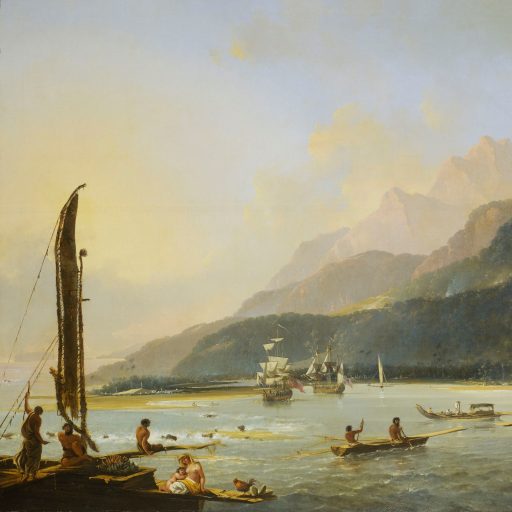A. Douglas Gibson of the Captain Cook Society wrote a summary of the history of the exploration vessel Endeavour. A senior moment prevented the author of Picturing The Pacific from revising his text to explain what is elucidated by Gibson below that was originally published in Cook’s Log, page 18, volume 1, number 3 (1976).
He wrote: “In March 1768 the British Admiralty had decided to purchase the East-coast collier and Whitby-built bark the Earl of Pembroke for the expedition sponsored by the Royal Society of London to observe the transit of Venus in 1769. She was 3½ years old, built by Fishburn of Whitby and owned by Thomas Milner. On April 1st the Secretary of the Admiralty advised the Council of the Royal Society of the purchase and James Cook was selected for command of the expedition.
The Earl of Pembroke was renamed the Endeavour Bark after being sheathed with additional light planking and fitted out at Deptford Naval Yards on the Thames. The word “bark” in Cook’s days was not synonymous with our own term “barque”. At the present time a barque is a square-rigged ship, except that the mizzen-mast is a fore-and-aft rigged. A “bark”, so far as the Endeavour was concerned’, meant a “cat” or bluff-bowed boat of shallow draught with rigging incomplete in the mizzen.
Cook was all in favour of this type of vessel because, if it grounded in shallow water, it had a much better chance of floating off than a heavy vessel. Indeed, it was this decision which saved the expedition from disaster when the Endeavour foundered on Endeavour Reef. A vessel of 368 tons, her over-all length was 105 feet, the length of her lower deck 97 feet, her greatest breadth 29 feet 3 inches, depth of hold 11 feet and a draught of some 14 feet when fully laden. She did not carry any ornamental figurehead on the prow or stern.
The Endeavour had a broad floor, square stern, and round tumbling-in sides. She had ample space for provisions and stowage in her hold. The decks had hollowness amidships, the quarter-deck was above the waist and the poop rose above the quarter-deck. The mast had no rake, but stood at right angles to the waterline. She carried a sprit-sail, a hanging square sail, to be used in scudding.
Sailing from Deptford on 30 July 1768, the Endeavour stopped at Plymouth on 13 August for 5 days to pick up Banks and his party, and to arrange accommodations for Dr Solander. A total of 95 persons were on board, 94 leaving England and one seaman being impressed at Madeira. Replacements for lost crew members were obtained at various ports later in the voyage. Fifty-six of the original 94 reached home 2 years and 11 months later.
The Endeavour originally cost £2,840 10s 11d; alterations for the first voyage cost £5,394 15s 4d; subsequent refits £3,563 10s 10d, a total of £11,798 17s 1d. After exactly seven years she was sold for £645 in 1775.
After her first world voyage she was used as a store-ship and made three trips to the Falkland Islands. Then she went back to the coal trade in the North Sea from which she had come. In 1790 the French Government, desirous of competing with England in the whale fisheries, offered a bounty for whalers under the French flag. Captain William Hayden of New Bedford, Massachusetts, bought the Endeavour through the firm of Du Bacque Freres of Dunkirk and registered her under French colours as La Liberte.
In 1793 she put in to Newport with a cargo of oil and ran aground. She was purchased by John Cahoon and broken up. The Newport newspapers confirm her as the ex-Endeavour. Some of her principle timbers were stamped with the name and the information is accompanied by the Certificate of the British Consul at Newport.
It is fitting that a piece of her timbers is to be found in a small museum that has been established at Kurnell, Botany Bay, New South Wales, where Cook made his first landing on Australian soil. One of her cannons, which was raised from Endeavour Reef, now can be seen in perfect condition there”.
Contributed by Dr James Taylor, FRSA [30 July 2018]
